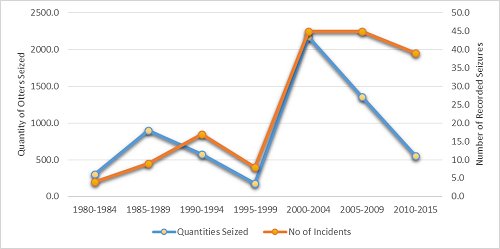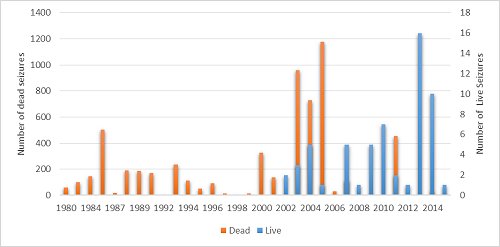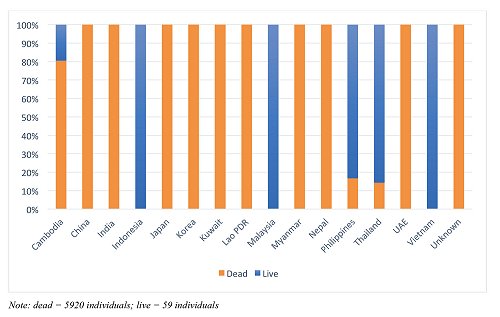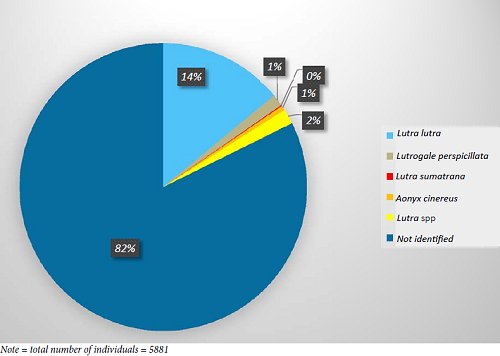IUCN/SSC Otter Specialist Group Bulletin

©IUCN/SCC Otter Specialist Group
Volume 34 Issue 2 (October 2017)
Citation: Gomez, L, Leupen, BTC, Theng, M, Fernandez, K and Savage, M (2017). Illegal Otter Trade: An Analysis of Seizures in Selected Asian Countries (1980-2015) - Summary. IUCN Otter Spec. Group Bull. 34 (2): 104 - 114
Illegal Otter Trade: An Analysis of Seizures in Selected Asian Countries (1980-2015) - Summary
[This paper is a summary of a larger report that was published by TRAFFIC and the OSG at the 13th IUCN International Otter Congress in July 2016 and presents an overview of the key findings. The full report is available for download on the TRAFFIC website: http://www.traffic.org/species-reports/traffic_species_mammals95.pdf]
Lalita Gomez1, Boyd T.C. Leupen1, Meryl Theng1, Katrina Fernandez2 and Melissa Savage3
1TRAFFIC, Regional Office in Southeast Asia, Petaling Jaya, Malaysia. Email: lalita.gomez@traffic.org
2Member of the Otter Specialist Group. Email: Katrina.fernandez@gmail.com
3The Four Corners Institute. Email: forests@g.ucla.edu
| Download PDF (353 KB) |
| Abstract: This study is an analysis of records of the seizure of otters by law enforcement agencies in selected Asian countries between 1980 and July 2015. The study was undertaken to understand the extent and scale of the illegal otter trade in Asia, and focussed on four Asian otter species i.e., the eurasian otter (Lutra lutra), hairy-nosed otter (Lutra sumatrana), small-clawed otter (Aonyx cinereus), and the smooth-coated otter (Lutrogale perspicillata). All four species were documented in illegal trade, with 161 recorded otter seizures across 15 countries in Asia between 1980 and 2015, involving an estimated 5881 individuals. Otter skins constituted the majority of the seizures, particularly in India, Nepal and China. Since early 2000s, there seems to be a rising demand for otter pups for the pet trade, particularly in Indonesia, Malaysia, Thailand and Viet Nam. While seizure records as a whole were scarce across the region, we conclude that illegal otter trade is persistent and largely unchecked, despite otter species being legally protected across their range. |
| Keywords: illegal otter trade, Asian otters, skin trade, pet trade |
| Française | Español |
INTRODUCTION
Wild otter populations in Asia are declining due to the increasing loss of suitable habitat and human-otter conflicts because of their perceived or actual threat to local and commercial fisheries. A further significant threat to their survival, although little understood, is illegal trade. Historically, the otter trade has had a global occurrence, with the Sea Otter skin trade in North America starting in the 18th century and lasting until the beginning of the 20th century (by which time reintroduction programmes were required to save the species from extinction) (Carlson, 2002; Kruuk, 2006). It was the dense and durable properties of otter furs that made them so valuable in the then flourishing fur business. The historical demand for otter fur has resulted in the hunting of different otter species around the world, and has caused the deaths of hundreds of thousands of animals, driving several species to near extinction in many range States (Foster-Turley and Santiapillai, 1990; Kruuk, 2006; Nawab and Gautam, 2008; Duckworth, 2013).
In Asia, particularly in Bangladesh, India and Nepal, illegal hunting of otters for their skin is ongoing and poses a severe threat to regional otter populations. Early 21st century seizure data suggest that 20–30 percent of the Indian fur trade then involved otter skins (Meena, 2002). Otter poaching on the Indian subcontinent is largely aimed at meeting the high demand in the Chinese market (WWF, 2015). It has been found that at least 50 percent of otter skins in China originate from India (Ghosh, 2005; Duckworth, 2013). Reports of otter furs being popular for sale in the Tibetan Autonomous Region (TAR) and other provinces of China have further been confirmed by Tsering (2005) and WWF (2007). Past research suggests important markets are also found in Japan, South Korea and the Russian Federation (Kruuk, 2006). While little information exists on otter populations in India, it is known that intensive trapping has resulted in severely fragmented otter populations that are now largely restricted to protected areas (Khan et al., 2014). A discussion group on the use of and trade in otters in Asia evolved in the margins of the 7th IUCN International Otter Colloquium in Trebon, Czech Republic, in 1998 (Melisch, 1998). However, the magnitude of the illegal Asian otter trade was particularly evident when remarkable quantities of otter skins were discovered during a joint study by the Environmental Investigation Agency (EIA) and the Wildlife Protection Society of India (WPSI) into the big cat skin trade in China (Banks et al., 2006). Openly for sale in local markets, otter skins were often found alongside Tiger Panthera tigris and Leopard P. pardus skins (in two years, no fewer than 1800 otter skins were recorded on a single market in Linxia, China). In China, these skins are used as outer linings of coats, to make hats, to embellish traditional garments like the Tibetan Chupa, or as trophies for display during festivals and sporting events.
Otters are also popular as pets, particularly as youngsters. In Indonesia, there are at least 800 private otter owners (IOSF, 2014). Observations of live otters for sale in wildlife markets in Jakarta, Indonesia have increased from incidental observations made in the late 1980s and early 1990s in West Java (R. Melisch, pers. comm., 2016), to become more widespread over the past decade as observed during market surveys across Southeast Asia albeit in small numbers (C.R. Shepherd, pers. comm., 2016).
Apart from scattered information on otter trade, there is very little understanding of the illegal trade of otters in Asia, and therefore little has been done to tackle this trade. In light of this rising threat, TRAFFIC, in partnership with the IUCN/SSC Otter Specialist Group, undertook an analysis of otter seizure records in the region between 1980 and July 2015 (Gomez et al., 2016). The study was initiated to assess the illegal trade in four otter species distributed in Asia: Eurasian Otter (Lutra lutra) (Near Threatened on the IUCN Red List of Threatened Species), Hairy-nosed Otter (Lutra sumatrana) (Endangered), Small-clawed Otter (Aonyx cinereus) (Vulnerable) and Smooth-coated Otter (Lutrogale perspicillata) (Vulnerable). A fifth Asian species, Sea Otter (Enhydra lutris), which occurs in some of the eastern coastal areas of the Russian Federation and has incidentally been observed in northern Japan, was excluded from this study due to its northern Pacific coastal distribution and very different past use and trade dynamics.
METHODS
Records of seizures by law enforcement agencies between 1980 and July 2015 of live or dead otters, and/or their parts and derivatives, in selected countries and territories in Asia were collected and analysed. Information on otter seizures included, when available: date and location of seizure, country/territory or countries/territories, origin and destination of products, seized item type, quantity, and enforcement agencies involved. Formal requests for otter seizure records were sent to all relevant CITES Management Authorities in the following countries/territories across Asia: Bangladesh, Bhutan, Cambodia, China (including Hong Kong), India, Indonesia, Lao PDR, Malaysia, Myanmar, Nepal, Pakistan, Singapore, Sri Lanka, Thailand, and Viet Nam. These countries/territories were selected on the basis of their previous involvement in illegal wildlife trade and/or their proximity to known fur-trade hubs (such as India). Not all countries contacted responded to our request for records and of those that did, some did not provide records. Data on seizures were also obtained from other sources, including TRAFFIC, various NGOs and open access sources such as that reported by the online media. Any additional Asian countries where seizure data were encountered during these searches (i.e. Japan, South Korea, Kuwait, the Philippines and the United Arab Emirates) were also included in the database. General trade data, including seizure data, were also extracted from the United Nations Environmental Programme-World Conservation Monitoring Centre (UNEP-WCMC) CITES trade database, a collection of all records of import, export and re-export of listed species, as reported by Parties to the CITES Secretariat. The analysis of illegal otter trade across selected countries/territories in Asia should be considered precautionary, as it is assumed that the analysed seizure records represent only a portion of the actual trade, since only a fraction of illegal trade is intercepted, seized, and/or reported. To avoid overlap between the various sources of data analysed, all seizures compiled during this study were rigorously crosschecked to prevent duplication within the dataset. Seizure data were also omitted where a credible source could not be verified or in cases where details were lacking or vague.
Scope of Data
It must be noted that this study's dataset is far from comprehensive. For nearly all countries/ territories included in this study, annual seizure records (national or CITES) are absent throughout most of the 1980–2015 period. For some years (1982, 1983, 1985 and 1991), no seizure data were found at all. These data deficits may be explained by several factors. Firstly, countries/territories may lack sufficient enforcement efforts, resulting in a small number of seizures and a higher percentage of undetected trade. Secondly, enforcement agencies may neglect to report seizures, causing national seizure data to be incomplete and/or absent. Thirdly, in some cases, national governing bodies may be unwilling to share seizure data with third parties. Finally, because of the trade's inherently secretive nature, large parts of it are bound to go undetected, rendering it impossible to determine its full extent on the basis of seizure data only.
The dataset shows that seizure records for the earlier years of the studied timeframe are scarcer than more recent records. Besides the above-mentioned factors, this scarcity may be explained by the unavailability of older documents and their absence from more modern open source facilities such as the Internet. Other gaps in older records may be explained by the CITES-membership status of the country in question. Some of the analysed countries only became signatories to CITES after 1980. Prior to their CITES-membership, these countries were not obligated to report seizures to the CITES Secretariat. The countries include Bangladesh (CITES signatory in 1982), Cambodia (1997), China (1981), India (1976), Lao PDR (2004), Myanmar (1997), the Philippines (1981), Thailand (1983) and Viet Nam (1994).
The data gaps in this study lead to an underrepresentation of illegal trade records and stand in the way of a comprehensive overview of the illegal otter trade, which is likely to be much larger than the data suggest. Additionally, other potentially important illegal trade channels must be taken into account. Casual browsing of trading websites has hinted at the importance of the Internet in the illegal otter trade although a study of this was outside the scope of the current study.
RESULTS AND DISCUSSION
Fur and Pet Trade
All four species were documented in illegal trade, with 161 recorded otter seizures across 15 countries in Asia between 1980 and 2015, involving an estimated 5881 individuals. A large majority of the recorded seizures took place in India, suggesting both a well-established Indian otter trade, and comparatively effective local law enforcement in that country. The remaining seizures occurred in China and Cambodia and to a lesser extent Nepal. All otter seizures in these countries involved skins in significant quantities, suggesting that otters are specifically targeted by poachers to meet a market demand for their fur. Seizure records suggest that large numbers of otter skins are smuggled from India to China through Nepal. Past research has illuminated important trade routes between India, Nepal, and China (Banks, 2004; Banks et al., 2006; Verheij et al., 2010; Stoner and Pervushina, 2013).

|
| Figure 1. Total number of seizures recorded annually and quantities of otters seized. (click for larger version) |
A decline in the number of recorded otter skin seizures observed from 2005 onwards suggests waning trade levels (Figure 1). However, such a drop in seizure numbers may reflect weakened enforcement efforts and an increase in undetected trade. Similar lows in seizure data have occurred before, most notably between 1996 and 2000, after which seizure levels rose again, reaching a peak between 2003 and 2005. Furthermore, recent reports have shown the continuing extent of the trade in wild animal fur in the region (Verheij et al., 2010; Stoner and Pervushina, 2013). It is therefore too early to hint at a declining demand for otter furs. A more serious concern is that this decline in recent seizure records may be a sign of declining otter populations. The illegal otter trade has already been attributed as a key factor leading to the extinction of otters in parts of India (IOSF, 2014). The same has been reported for otter population in China where they were once widespread - demand for fur and live otters resulted in the near extirpation of the Eurasian Otter (Lau et al., 2010). Population levels of the species are still considered very low in southern China, and populations are thought to be present only in well protected areas (Lau et al., 2010). Poaching activities have also resulted in the depletion of otter populations in Myanmar where they have been hunted not just for their fur but also for their gall bladder and penis (Zaw et al., 2008).
The recent spike in illegal trade records of live animals suggests that the trade in otters for pets may now be increasing (Figure 2). The seizure data show that the number of live individuals in illegal trade has been on the rise since the 2000s particularly in Indonesia, Malaysia, Thailand and Viet Nam (Figure 3). However, the number of live otter seizures thus far remains relatively small. This may be an indication that the illegal otter pet trade mainly involves domestic markets. Of all the seizures involving live otters, there was only one incident where international trade was involved, i.e. the seizure of five small-clawed otters and six smooth-coated otter pups at Bangkok's Suvarnabhumi International Airport, reportedly headed for Japan's exotic pet market (Shepherd and Tansom, 2013). That said, it would be premature to conclude that there is no demand for pet otters. Indeed, CITES trade records show that a large part of the commercial international trade in otters concerned shipments of captive-bred live small-clawed otters.

|
| Figure 2. Number of dead vs live individuals seized per year (click for larger version) |

|
| Figure 3. Percentage of dead vs live individuals per country (click for larger version) |
There has also been a noticeable shift in the trade of wildlife from physical markets to online markets in recent years (Anon, 2014; Krishnasamy and Stoner, 2016). Preliminary scans of social media websites and trade fora have given us a glimpse of a flourishing online wild otter pet trade in Indonesia, Malaysia and Viet Nam. While actual transactions may only involve small numbers of otters, the frequency of such transactions appears to be high. A random glance at the online trade of otters in Viet Nam revealed at least 10 e-commerce websites and forums advertising otters as pets. In Viet Nam, as in Malaysia, otter seizures exclusively involved live individuals. In a recent assessment of the wildlife trade on Facebook in Peninsular Malaysia in the five months from November 2014 to April 2015, otters were highlighted as one of the most popular pet species in trade (Krishnasamy and Stoner, 2016). This was also found to be the case in Indonesia (Aadrean, 2013), and Brunei (Anon, 2014). The online illegal otter trade is likely to be substantial, and increasing, in both scale and scope. The lack of online otter trade records is perhaps the greatest gap in this study's dataset. To establish a more complete overview of the live otter trade, comprehensive assessments of the online trade are urgently needed to understand the scale and impact on wild populations and identify appropriate interventions to disrupt the trade.
Identification of Asian otters to a species level is difficult. It is exceptionally hard to distinguish between otter species, especially when dealing with skins and body parts. It is therefore unsurprising that 82% of seized otters in this study were not identified to the species level (Figure 4). Many of these were from seizures in India and China. This lack of information should be considered problematic and obstructive to conservation efforts for several reasons, the most important one being that whenever illegally traded otters remain unidentified, it becomes impossible for researchers to determine which otter species should be prioritized in conservation plans. In a similar vein, it becomes impossible to identify trends regarding the use of various species for different purposes and the demand for the different species in particular countries. Nevertheless, certain trends can be discerned from the individuals that were identified. All four Asian otter species assessed in this study were found in trade.

|
| Figure 4. Seized otter species recorded (click for larger version) |
 |
Eurasian otters represented the highest number of identified individuals in seizure records (824 individuals; 87.6% of all identified individuals). This was mostly attributed to one large seizure of 778 skins in China in 2003. The skins originated in India and were in transit to the TAR along with 31 tiger skins and 581 leopard skins. No live Eurasian otters were encountered in any seizure records. Rather, recorded seizures of the species almost exclusively involved skins, confirming the species' popularity in the fur trade. Eurasian otters have the broadest habitat range of all otter species, which makes it difficult to establish any seized specimen's exact origin whenever such information is not recorded. Nevertheless, India and China's well-established fur trade means that these countries will continue to play an important role in the Eurasian otter trade. |
 |
The smooth-coated otter is also traded primarily for its fur. A large proportion of seizures of this species were skins and to a much lesser extent, carcass and tail. There were also several seizures of live individuals, reportedly destined for the pet trade. Many of the seizures were reported in Cambodia (70%), where this species is coveted by locals for use in traditional medicine (Poole, 2003). Such medicinal use includes otter skins used to assist women during pregnancy and childbirth. These practices may still occur in Cambodia, and the traditional medicine industry, and increasingly the pet trade, may pose significant threats to the smooth-coated otter and possibly even the endangered hairy-nosed otter, the only other otter species seized in that country. |
 |
The hairy-nosed otter was by far the least encountered species in trade records, with only six individuals seized between 2002 and 2008 in five separate incidents. This is not surprising as it is the rarest otter species in the region and has recently been rediscovered in Cambodia, Indonesia, Malaysia, Thailand and Viet Nam (Aadrean et al., 2015). All five seizure records for this species occurred in Cambodia. Of the six individuals seized, three were live and three were skins. It is impossible to draw any conclusions with regards to their trade and use with such a scarcity of seizure data. Nevertheless, given this species is already under severe pressure, any level of trade is likely to pose a significant risk to its survival. |
 |
Small-clawed otters are a popular species in the pet trade. CITES trade records show that nearly all legally traded small-clawed otters were live. More than half of all seizures reported for the species were of live individuals, albeit in small quantities (67.7%). These seizures occurred in Indonesia, Malaysia, Philippines, Thailand and Viet Nam. In India, the species is hunted for its fur and populations have reportedly been drastically reduced over the last decade (IOSF, 2014). There was one reported seizure of nine small-clawed otter skins in India in 2014. |
CONCLUSION
This study was born out of a desire to understand the extent and scale of the illegal trade in four Asian otter species, in order to facilitate future research and action plans. However, there is a paucity of information on the illegal trade of otters in the Asian region. This is due to the fact that wildlife crime is still a low priority for governments and furthermore, otters are a low priority species for most conservation organizations. Seizure data were scarce for most countries assessed in this study with the exception of India. The real scale and scope of the Asian illegal trade in otters is therefore difficult to determine. The inherently secretive nature of the trade means that most illegal shipments go undetected. Additionally, the incompleteness of seizure data (due to poor enforcement and/or reporting) stands in the way of any conclusive measurement of the true extent of the issue. Wherever trade records are scarce, it is difficult to establish whether this is due to actual low trade levels or due to a lack of reporting.
Nevertheless, based on the seizure records acquired, it can be concluded that the illegal trade in otters is persistent and largely unchecked, even though the four Asian otter species receive a variety of legal protections across their range. While this study provides a preliminary understanding of the role of the illegal trade in endangering otter populations in parts of Asia, it also highlights the significant gaps in our knowledge that need to be addressed in order to mitigate these threats. First, the true extent of the trade remains unknown due to its inherently covert nature. Estimates in this report are likely to under-represent the magnitude of the trade. Second, little is known about the status of the four Asian species - uncertainty about population sizes, reproduction rates and in some cases distribution, makes it difficult to determine the resilience of each species in the face of exploitation. Third, in most seizure data, otters were not identified to the species level, which clearly poses an obstacle to estimating the impacts of the trade on the different otter species, and complicates the task of prioritizing species of concern for conservation action.
Further investigation is therefore urgently required to establish a more complete overview of the illegal otter trade in the region, including market and trade route surveys in key areas to identify trafficking hot spots and scale of the trade. Assessments of the online trade are also critically needed to better understand these new trading platforms and enhance protection of Asian otters. Underpinning the need to understand the illegal trade in otters is the need for research into the status of these four Asian otter species across their range so as to understand the impact of illegal trade on wild populations.
REFERENCES
Aadrean, A. (2013). An Investigation of Otters Trading as Pet in Indonesian Online Markets. Jurnal Biologika 2(1):1–6.
Aadrean, A., Kanchanasaka, B., Heng, S., Reza Lubis, I., de Silva, P. and Olson, A. (2015). Lutra Sumatrana. International Union for Conservation of Nature Red List of Threatened Species 2015. http://dx.doi.org/10.2305/IUCN.UK.2015-2.RLTS.T12421A21936999.en. Viewed 26th February 2016.
Anon. (2014). Otter up for sale on Facebook. Borneo Bulletin Online - The Independent Newspaper in Brunei Darussalam, Sabah and Sarawak, Published 12th November 2014. http://borneobulletin.com.bn/otter-sale-facebook/ Viewed 20th June 2016.
Banks, D. and Newman, J. (2004). The Tiger Skin Trail. Environmental Investigation Agency, London, UK.
Banks, D., Desai, N., Gosling, J., Joseph, T., Majumdar, O., Mole, N., Rice, M., Wright, B. and Wu, V. (2006). Skinning the Cat: Crime and Politics of the Big Cat Skin Trade. Environmental Investigation Agency, London, UK and Wildlife Protection Society of India, New Delhi, India.
Carlson, J.D. (2002). The ‘Otter-Man’ Empires: The Pacific Fur Trade, Incorporation and the Zone of Ignorance. Journal of World-systems Research 8(3): 390-442.
Duckworth, W. (2013). Otter Fur Trade in Asia. In: Anon. (Eds), Asian Otter Conservation Workshop 25th-30th November 2013, International Union for the Conservation of Nature Species Survival Commission – Otter Specialist Group and the National Centre for Biological Sciences, Bengaluru, India. Pp. 7-8.
Foster-Turley, P.A. and Santiapillai, C. (1990). Action Plan for Asian Otters. In: Foster-Turley, P., Macdonald, S and Mason, C. (Eds), Otters: An Action Plan for Their Conservation. IUCN SSC Otter Specialist Group.
Ghosh, A. (2005). Otters: Dressed to Kill. The Times of India (India), Viewed 29th September 2015.
Gomez, L., Leupen, B.T.C., Theng, M., Fernandez, K. and Savage, M. (2016). Illegal Otter Trade: An Analysis of Seizures in Selected Asian Countries (1980-2015). TRAFFIC, Petaling Jaya, Selangor, Malaysia.
International Otter Survival Fund (2014). The Shocking Facts of the Illegal Trade in Otters. International Otter Survival Fund (IOSF), Broadford, Isle of Skye, Scotland, UK. 16pp.
Khan, M.S., Dimri, N.K., Nawab, A., Ilyas, O. and Gautam, P. (2014). Habitat Use Pattern and Conservation Status of Smooth-coated Otters Lutrogale Perspicillata in the Upper Ganges Basin, India. Animal Biodiversity and Conservation 37(1):69–76.
Krishnasamy, K. and Stoner, S.S. (2016). Trading Faces: A Rapid Assessment on the Use of Facebook to Trade Wildlife in Peninsular Malaysia. TRAFFIC Southeast Asia, Petaling Jaya, Selangor, Malaysia.
Kruuk, H. (2006). Otters: Ecology, Behavior and Conservation. Oxford University Press, New York. 265pp.
Lau, M.W., Fellowes, J.R., Chan, B.P.L. (2010). Carnivores (Mammalia: Carnivora) in South China: a status review with notes on the commercial trade. Mammal Review 40(4):247-292.
Meena, V. (2002). Otter Poaching in Palni Hills. Zoos’ Print Journal 17(2):696–698.
Melisch, R. (1998). Trade and Use of Otters and their Parts: How Large is the Conservation Impact? A First Approach towards Consumptive Use of Otters in Asia. In: IUCN/SSC Otter Specialist Group. VIIth International Otter Colloquium – Otter Conservation – an example for a sustainable use of wetlands by man. March 14–19, 1998, Trebon, Czech Republic. Abstracts. IUCN/SSC OSG.
Nawab, A. and Gautam, P. (2008). Otters: Can They be Saved?. In: Sengupta, M. and Dalwani, R. (Ed.), Proceedings of Taal2007: The 12th World Lake Conference, Jaipur, Rajasthan, India. Pp. 591–596.
Poole, C.M. (2003). The First Record of Hairy-nosed Otter Lutra Sumatrana from Cambodia with Notes on the National Status of Three Other Otter Species. Natural History Bulletin Siam Society 51(2):273-280.
Shepherd, C. and Tansom, P. (2013). Seizure of Live Otters in Bangkok Airport, Thailand. IUCN Otter Spec. Group Bull. 30(1):37-38.
Stoner, S.S. and Pervushina, N. (2013). Reduced to Skin and Bones Revisited: An Updated Analysis of Tiger Seizures from 12 Tiger Range Countries (2000–2012). TRAFFIC Southeast Asia, Petaling Jaya,Selangor, Malaysia.
Tsering, D. (2005). Survey Report on Illegal Trade, Market, and Consumption of Asian Big Cats Skins in Tibet. WWF, Tibet Academy of Social Sciences (TASS) and TRAFFIC; Beijing. 29pp.
Verheij, P.M., Foley, K.E. and Engel, K. (2010). Reduced to Skin and Bones: An Analysis of Tiger Seizures from 11 Tiger Range Countries (2000–2010). TRAFFIC International, Cambridge, UK.
WWF (2007). Asian Big Cat Species Market Survey of Tibet, Qinghai, and Gansu Provinces. WWF Lhasa Field Office Beijing. 14pp.
WWF (2015). Otter: Smooth-coated Otter. http://www.wwfindia.org/indian_otter.cfm. Viewed 3rd February 2015
Zaw, T., Htun, S., Po, S.H.T., Maung, M., Lynam, A.J., Latt, K.T. and Duckworth, J.W. (2008). Status and Distribution of Small Carnivores in Myanmar. Small Carnivore Conservation, 38:2-28.
Résumé: Commerce Illégal De Loutres : Une Analyze Des Saisies Dans Une Selection De Pays Asiatiques (1980-2015) - Résumé
Cette étude est une analyse des enregistrements des saisies de loutres par les organismes d'application de la loi dans une sélection de pays asiatiques entre 1980 et Juillet 2015. Cette étude fut menée pour comprendre l’étendu et l’échelle du commerce illégal des loutres en Asie, et fut ciblée sur 4 espèces de loutre asiatique qui sont la loutre d’europe (Lutra lutra), la loutre de sumatra (Lutra sumatrana), la loutre cendrée (Aonyx cinereus) et la loutre à pelage lisse (Lutrogale perspicillata). Ces 4 espèces ont été documentées dans le commerce illégale, avec 161 saisies de loutre enregistrées parmi 15 pays en Asie entre 1980 et 2015, impliquant une estimation de 5881 individus. La peau de loutre constitue la majorité des saisies, en particulier en Inde, au Népal et en Chine. Depuis le début des années 2000, il semble y avoir une hausse de la demande pour les jeunes loutres pour le commerce des animaux de compagnie, en particulier en Indonésie, Malaisie, Thaïlande et le Vietnam. Alors que l’enregistrement des saisies dans son ensemble étaient peu abondantes au sein de la région, nous concluons que le commerce illégal des loutres est persistant et largement non maitrisé en dépits du fait que ces espèces de loutre sont légalement protégées
Revenez au dessus
Resumen: Comercio Ilegal De Nutrias: Un Análisis De Incautaciones En Países Asiáticos Seleccionados (1980-2015) - Resumen
Este estudio es un análisis de los registros de incautación de nutrias por agencias de fiscalización y autoridades de aplicación en países Asiáticos seleccionados, entre 1980 y Julio de 2015. El estudio fue llevado a cabo para entender la extensión y escala del comercio ilegal de nutrias en Asia, y está focalizado en cuatro especies Asiáticas de nutria, la nutria Eurasiática (Lutra lutra), la nutria de Sumatra (Lutra sumatrana), la nutria de uñas pequeñas asiática (Aonyx cinereus) y la nutria lisa (Lutrogale perspicillata). Las cuatro especies fueron documentadas como apareciendo en el comercio ilegal, con 161 incautaciones registradas de nutrias, en 15 países en Asia entre 1980 y 2015, involucrando estimativamente 5.881 individuos. La mayoría de las incautaciones estuvieron constituidas por pieles, particularmente en India, Nepal y China. Desde principios de los 2000, parece haber una creciente demanda de crías de nutria para el comercio de mascotas, particularmente en Indonesia, Malasia, Tailandia y Viet Nam. Aunque los registros de incautaciones tomados como un todo fueron escasos a escala de toda la región, concluimos que el comercio ilegal de nutrias es persistente y en gran parte inadvertido o sin control, a pesar de que las especies de nutria están legalmente protegidas en toda su distribución.
Vuelva a la tapa